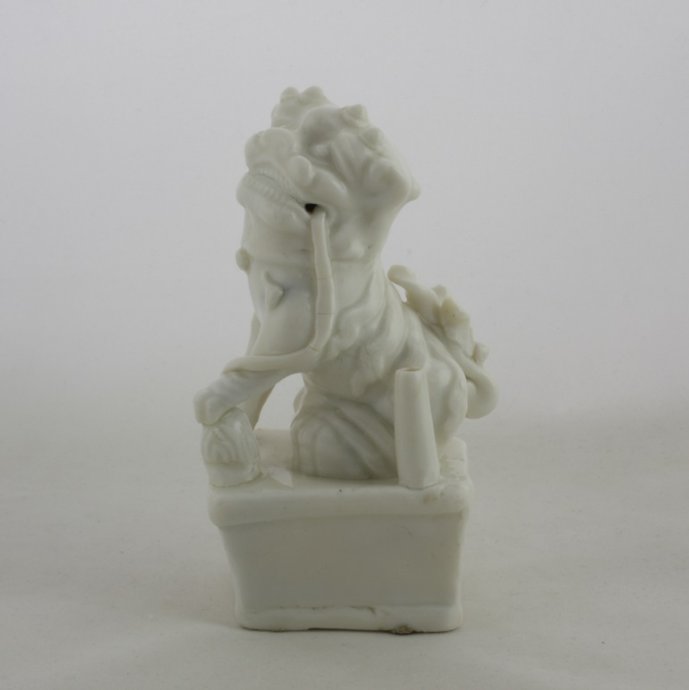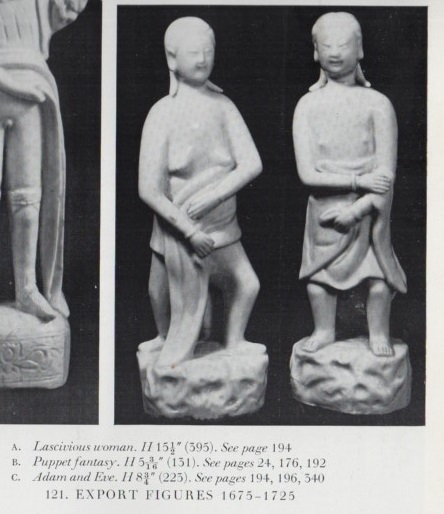Sold Ceramics
Sold Dehua wares 1600-1900
Page 1
The white, undecorated blanc de Chine with its ivory-grey or creamy-white glaze on a thick, pure-white body was produced in kilns in and around Dehua in southern China. Since the late 16th century, potters there specialised in figures of animals and Chinese Immortals, especially of Guanyin, the patroness of women, poor people and fishermen. Unusually for Chinese depictions of women, Guanyin has bare feet. Occasionally figures of Europeans were made, sometimes riding a mythical animal, and even statues of Mary and Child or Mary and a monk are known. Apart for export, these figures might also have served as curiosities or 'Western exotics' for Chinese collectors. Figures and other items such as teapots, covered boxes and vases were made in moulds. Interesting are the so-called libation cups, modelled after examples made from rhinoceros horn. The rough surface and sometimes even the imprint of the potter's fingers can be seen on the inside of hollow figures. Decorations in relief, for instance of plum blossom, are hardly detailed. It is the thick, shiny glaze emphasising the simple form that makes blanc de Chine so attractive. In particular on figures, blanc de Chine may have a potter's or workshop mark. Blanc de Chine was much in demand in Europe as an exotic curiosity and figures were often overdecorated locally in black or red cold paint. Blanc de Chine figures are still being made in Dehua, often using the traditional techniques.

Sold Ceramics - Sold Dehua wares 1600-1900 - Page 1
Objects 2012644 & 2012645
A pair of (Adam and Eve) figurines
China
c.1700
Provenance object 2010C332 (Eve): Guest & Gray, object number Y269, The United Kingdom.
Provenance object 2010C333 (Adam): J.B.A.M. Ott Fine Arts, Zutphen, The Netherlands.
2012644 (Eve) Height 227 mm (5.24 inch), dimensions 75 mm (2.24 inch) x 60 mm (1.77 inch), weight 470 grams (7.44 ounce (oz.))
2012645 (Adam) Height 231 mm (5.24 inch), dimensions 75 mm (2.24 inch) x 65 mm (1.77 inch), weight 531 grams (7.44 ounce (oz.))
Two figures, blanc de Chine, Dehua kilns representing a half-naked man and a half-naked woman both with a robe wrapped around their lower bodies. Both standing on a pedestal in the form of a boulder. On the base of object 2010C332 (Eve) a circular paper dealers label with the text: Guest & Gray, a rectangular paper label with the handwritten text: Y269 Chinese blanc de chine Figure of Eve Kangxi (1662-1722) and a rectangular paper label with the text :259. * Statuette af frittelignende, elfenbenshvidt Porcellaen. En nogen, staande Kineserinde med Draperi. Prov. Fuhkien, 18. Aarh. >>Chien-yao<< Blanc de Chine. H. 22 Ctm. On the base of object 2010C333 (Adam) a rectangular paper dealers label with the text: J.B.A.M. Ott Fine Arts Zutphen, The Netherlands.
The white, undecorated blanc de Chine with its ivory-grey or creamy-white glaze on a thick, pure-white body was produced in kilns in and around Dehua in southern China. Since the late 16th century, potters there specialised in figures of animals and Chinese Immortals, especially of Guanyin, the patroness of womenSoutheast Asia / Other Ceramics, poor people and fishermen. Unusually for Chinese depictions of women, Guanyin has bare feet. Occasionally figures of Europeans were made, sometimes riding a mythical animal, and even statues of Mary and Child or Mary and a monk are known. Apart for export, these figures might also have served as curiosities or 'Western exotics' for Chinese collectors. Figures and other items such as teapots, covered boxes and vases were made in moulds. Interesting are the so-called libation cups, modelled after examples made from rhinoceros's horn. The rough surface and sometimes even the imprint of the potter's fingers can be seen on the inside of hollow figures. Decorations in relief, for instance of plum blossom, are hardly detailed. It is the thick, shiny glaze emphasising the simple form that makes blanc de Chine so attractive. In particular on figures, blanc de Chine may have a potter's or workshop mark. Blanc de Chine was much in demand in Europe as an exotic curiosity and figures were often overdecorated locally in black or red cold paint. Blanc de Chine figures are still being made in Dehua, often using the traditional techniques.
Christian influence
This is perhaps the point at which to introduce the figures, naked from the waist up, known in Europe as Adam and Eve (Plate 121c). The male figure is sometimes called The Slave, but this I think is no more than a dealer's term, for slaves in China were not dressed (or undressed) in this fashion. They are innocuous enough little figures, the legs rather clumsily modelled, perhaps indicative of our potter's unfamiliarity with that part of the human anatomy. they are certainly not medical figurines shown to the doctor as a substitute for physical examination, for the female figure in that case would not be partially clad, and there would be no need at all for the male one. It is easier by far to say what these figures are not that what they are. I have put them into the export category firstly because their hair styles (there is little else to go by) seem vaguely European, and secondly because they are found in Europe in fair numbers, but van Goidsenhoven published a version of the female figure with a manifestly Chinese hair style, a high comb-like roll encircling the forehead. he suggests she may be T'an-ki, a famous concubine of the Emperor Tsu of the Yin dynasty. She is said to have caused young people of both sexes to discard their clothes, and encouraged their excesses. I find myself unable to give this story any more credence than those other offerings from that author, and his explanation does nothing to explain the existence of the young man. It is curious, too, that the woman is the taller of the pair -is there any folklore significance here? The dating of these figures to the K'ang-hsi period presents no problem, since Augustus the Strong had six examples of Eve [N25] before 1721. At that time her hair was painted black, and since the cataloger records two sizes, 9 and 9 1/2 inch, he probably had the model recorded by van Goidsenhoven as well. Adam is missing unless he lurks, painted, in the red section of the inventory. The quality is good apart from the rather poor modelling already mentioned (Donnelly 1969, p.194, p.196 & p.340)
(Reproduced from: Blanc de Chine. The Porcelain of Têhua in Fukien, (P.J. Donnelly, Faber and Faber, London, 1969), fig 121c)
Normally they are not together but they are constructed as a pair. Adam and Eve is their Western name. However, they can also be figures that represent Filipino or Taiwanese aboriginals. They are fairly rare figures, certainly a couple.
For identically shaped and sized Adam and Eve figurines, please see;
- Blanc de Chine. The Porcelain of Têhua in Fukien, (P.J. Donnelly, Faber and Faber, London, 1969), fig 121c.
- SKD Online collection, PO. 3249.
Condition: Both perfect.
References:
Donnelly 1969, p.194, p.196 & p.340, fig 121c
SKD Online collection, PO. 3249.
Price: Sold.

Sold Ceramics - Sold Dehua wares 1600-1900 - Page 1
Object 2011683
Buddhist lion or Fo-dog joss-stick holder
China
1650-1700
Height 133 mm (5.24 inch), dimensions 57 mm (2.24 inch) x 45 mm (1.77 inch), weight 211 grams (7.44 ounce (oz.))
Male Buddhist lion or Fo-dog joss-stick holder with raised beads, flammiform manes and tail, seated on a high hollow rectangular plinth, its left-hand forepaw resting on an embroided ball a taper (joss-stick) holder in one corner base.
In China a stone lion and lioness often serve as guards before a palace or temple. The male is holding a stitched ball under his claw. The lioness has a cub under her fore-claw. According to other legends the ball is really an egg with the cub inside, or a pearl which the lion is playing with to quieten his mind. This particular model, with the tube at the side for incense, often is referred to as joss-stick holder. (Hartog 1990), (Sargent 2012)
The lion is not indigenous to China, but early Buddhists, for whom it is sacred, introduced its image. So popular was this figure that it can be found, in wide range of media from metal, jade, stone, wood, and enamel to ceramic. Outside China the Dehua lions exported from China as early as the 1640s were referred to simply as lions or monsters and undoubtedly were collected for novelty's sake. The Chinese lions were also copied in Europe. (Sargent 2012)
During the Kangxi period figures of animals became popular for the internal market as well as for export. These figures produced in great variety, were bought as exclusive objects by private European traders and much appreciated in the West as decorative and exotic items for prominent display in the interior. (Jörg & Van Campen 1997)
These Buddhist lions or Fo-dogs were amongst the earliest of all blanc de Chine models to reach Europe. Ottema (Ottema 1943) makes possibly the first mention of such 'white porcelain lions' which appear in an inventory of the effects of the painter Jan Bassé the Elder in 1637 (a reference not previously noted by writers on blanc de Chine). (Howard & Ayers 1978, vol. 1)
Similar Buddhist lions, Fo-dogs were found in the so-called Hatcher cargo of 1643-1646. (Sheaf & Kilburn 1988)
For identically Buddhist Lions (Fo-dosgs), please see;
- Chineesche Ceramiek. Handboek. Geschreven naar aanleiding van de verzameling in het museum het Princessehof te Leeuwarden, (N. Ottema, N.V. Drukkerij en Uitgeverij J.H. de Bussy, Amsterdam 1943), pp.164-165, cat. 191 & 193.
- Chine de Commande, (D.F. Lunsingh Scheurleer, Hilversum, 1966), p.161, cat. 314.
- Blanc de Chine. Katalogus wit geglazuurd Chinees porselein uit Têhua en enige aanverwante stukken / Catalogue white glazed Chinese porcelain from Têhua and some related objects, Groninger Museum, (J.M. Cochius, Groningen, 1974), p.11, cat 24 & 25.
- China for the West. Chinese Porcelain and other Decorative Arts for Export illustrated from the Mottahedeh Collection, (D.S. Howard & J. Ayers, Philip Wilson Publishers for Sotheby Parke Bernet Publications, London 1978), vol. 1, pp.100-101, cat. 68 & 69.
- Chinesisches und japanisches Porzellan in europäischen Fassungen, ( D.F. Lunsingh Scheurleer, Verlag Klinkhardt & Biermann, Braunschweig, 1980), p.373, cat. 384.
- Magic Blanc de Chine, (M. Penkala, Interbook International, Schiedam1980), P.266, cat. CLXV.
- The Wrestling Boys. Chinese and Japanese Ceramics from the 16th to the 18th Century in the Collection at Burghley House, (The Trustees of Burghley House, Stamford 1981), p.94, cat. 245.
- The Hatcher Porcelain Cargoes. The Complete Record, (C. Sheaf & R. Kilburn, Oxford 1988), pp.27-29, Pl.17.
- Porzellan aus China und Japan. Die Porzellangalerie der Landgrafen von Hessen-Kassel, (Staatliche Kunstsammlungen Kassel, Berlin 1990), p.546, cat. 314a-d.
- Pronken met Oosters porselein, exhibition catalogue Gemeente Museum Arnhem, (S. Hartog, Waanders, Zwolle, 1990), p.93, cat. 98.
- A Tale of Three Cities Canton, Shanghai & Hong Kong. Three Centuries of Sino-British Trade in the decorative Arts. (D.S. Howard, Sotheby's, London 1997), p.83, cat. 89.
- Treasures of Chinese Export Ceramics from the Peabody Essex Museum, (W.R. Sargent, Salem, Massachusetts, 2012), p.199, plate 92.
- 300 Treasures, (F. Suchomel, Academy of Arts, Architecture and Design in Prague, Prague, 2015), p.468, cat. 291.
Condition: Perfect.
References:
Lunsingh Scheurleer 1966, cat. 314
Howard & Ayers 1978, vol. 1, cat. 68 & 69
Lunsingh Scheurleer 1980, cat. 484
Price: Sold.



 create websites
create websites